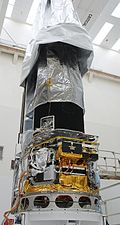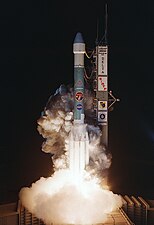Spitzer Space Telescope
The Spitzer Space Telescope (SST), initially known as the Space Infrared Telescope Facility or SIRTF, was a space observatory infrared, the fourth and last of NASA's Great Observatories. Other infrared space telescopes that preceded Spitzer were the IRAS and ISO telescopes.
It was launched on August 25, 2003 from the Kennedy Space Center using a Delta II as a vehicle. It maintained a heliocentric orbit similar to Earth's, but which moves it away from our planet at a rate of about 15 million kilometers per year. Spitzer is equipped with an 85 cm diameter reflecting telescope. The useful life of the Spitzer telescope is limited, as with other space infrared telescopes, by the rate of evaporation of the liquid helium that is used as a coolant. Initially, helium was expected to last a minimum of 2.5 years and a maximum of 5. Liquid helium ran out on May 15, 2009, giving it a life of more than 5.5 years.
After 16 years of activity, the Spitzer telescope was deactivated and retired on January 30, 2020.
The total cost of the mission has been estimated at $670 million. Among the technological challenges of this mission was the realization of the main beryllium mirror.
In keeping with NASA tradition, the telescope was renamed after its demonstration of successful operation on December 18, 2003. Unlike most telescopes, which are named by a panel of scientists, the name this was obtained from a contest open only to children. The final name comes from Dr. Lyman Spitzer, Jr., considered one of the most influential scientists of the 20th century and one of the first promoters of the idea of space telescopes proposing this possibility in the 1940s.
With Spitzer we want to study cold objects that go from the outer solar system to the ends of the universe. This telescope is the last element of NASA's Large Observatories program, and one of the main elements of the Astronomical Search for Origins Program (Astronomical Search for Origins Program). The telescope contains three instruments capable of imaging, photometry in the 3 to 180 micron range, and high resolution spectra in the 5 to 100 micron range.
History
In the early 1970s, astronomers began to consider placing an infrared telescope above the dimming effects of Earth's atmosphere. In 1979, a report by the National Research Council of the National Academy of Sciences, titled A Strategy for Space Astronomy and Astrophysics for the 1980s, identified a Shuttle Infrared Telescope Facility (SIRTF) as "one of two major astrophysics facilities [to be developed] for Spacelab", a platform carried by a shuttle. Anticipating major results from an upcoming Explorer satellite and shuttle mission, the report also favored the "study and development of...long-duration spaceflight by infrared telescopes cooled to cryogenic temperatures". . 4;
The January 1983 launch of the Infrared Astronomical Satellite, jointly developed by the United States, the Netherlands, and the United Kingdom, to perform the first infrared survey of the sky, whetted the appetite of scientists around the world for missions tracking spacecraft by taking advantage of rapid improvements in infrared sensing technology.
Previous infrared observations have been made by both space-based and ground-based observatories. Ground-based observatories have the drawback that at infrared wavelengths or frequencies, both the Earth's atmosphere and the telescope itself radiate (glow) brightly. Also, the atmosphere is opaque at most infrared wavelengths. This requires long exposure times and greatly decreases the ability to detect faint objects. It could be compared to trying to look at the stars in the optician at noon from a telescope made of light bulbs. Previous space observatories (such as IRAS, the Infrared Astronomical Satellite, and ISO, the Infrared Space Observatory) were launched during the 1980s and 1990s, and great advances in astronomical technology have been made since then.
Most early concepts involved repeat flights aboard NASA's space shuttle. This approach was developed in an era when the Shuttle program was expected to support weekly flights of up to 30 days in duration. A May 1983 NASA proposal described SIRTF as a shuttle-attached mission, with a payload of evolving scientific instruments. Several flights were anticipated with a probable transition to a more extended mode of operation, possibly in association with a future space platform or space station. SIRTF would be a cryogenically cooled, 1 meter class multi-user facility consisting of a telescope and associated focal plane instruments. It would be launched on the space shuttle and remain attached to the shuttle as a space lab payload during astronomical observations, after which it would be returned to Earth for refurbishment before flying again. The first flight was expected to take place around 1990, with subsequent flights beginning about a year later. However, the Spacelab-2 flight aboard STS-51-F showed that the shuttle's environment was unsuitable for an onboard infrared telescope due to contamination from the relatively "dirty" vacuum in the spacecraft. associated with orbiters. In September 1983, NASA was considering the "possibility of a long duration SIRTF [free flight] mission".
Spitzer is the only one of the Great Observatories not launched by the Space Shuttle, as originally intended. However, after the 1986 Challenger disaster, the Shuttle-Centaur upper stage, which would have been needed to place it into its final orbit, was abandoned. The mission underwent a series of redesigns during the 1990s, mainly due to budgetary considerations. This resulted in a much more modest but still fully capable mission that could use the smaller Delta II expendable launch vehicle.
One of the most important advances of this redesign was the use of a rear-Earth orbit. Cryogenic satellites that require liquid helium temperatures (LHe, T ≈ 4 K) in a near-Earth orbit are often exposed to a large heat load from Earth and consequently require large amounts of LHe refrigerant, which then tends to dominate the total payload mass and limits mission life. Placing the satellite in solar orbit far from Earth allowed for innovative passive cooling. The solar shield protected the rest of the spacecraft from the Sun's heat, the far side of the spacecraft was painted black to improve passive heat radiation, and the spacecraft bus was thermally isolated from the telescope. All of these design choices combined to drastically reduce the total mass of helium needed, resulting in an overall smaller and lighter payload, resulting in huge cost savings, but with a mirror the same diameter as the originally designed. This orbit also simplified pointing the telescope, but required NASA's Deep Space Network for communications.
The main instrument package (telescope and cryogenic camera) was developed by Ball Aerospace & Technologies, in Boulder, Colo. The individual instruments were jointly developed by industry, academic, and government institutions, with the principals being Cornell, the University of Arizona, the Smithsonian Astrophysical Observatory, Ball Aerospace, and the Goddard Space Flight Center. The shorter wavelength infrared detectors were developed by Raytheon in Goleta, California. Raytheon used indium antimonide and a doped silicon detector in creating the infrared detectors. These detectors are 100 times more sensitive than those available at the start of the project during the 1980s. The far-infrared detectors (70-160 micrometers) were jointly developed by the University of Arizona and the Lawrence Berkeley National Laboratory (Lawrence Berkeley National Laboratory) using gallium doped with germanium. The spacecraft was built by Lockheed Martin. The mission was operated and managed by the Jet Propulsion Laboratory and the Spitzer Science Center, located on the Caltech campus in Pasadena, California.
Warm mission and end of mission
Spitzer ran out of liquid helium coolant on May 15, 2009, halting far-infrared observations. Only the IRAC instrument remained in use, and only in the two shorter wavelength bands (3.6 μm and 4.5 μm). The telescope's equilibrium temperature was then around 30 K (−243 °C), and IRAC continued to produce valuable images at those wavelengths as the "Spitzer Warm Mission".
At the end of the mission, ~2016, Spitzer's distance from Earth and the shape of its orbit meant that the spacecraft had to tilt at an extreme angle to point its antenna at Earth. Solar arrays did not they were fully illuminated at this angle, and this limited those communications to 2.5 hours due to battery depletion. The telescope was decommissioned on January 30, 2020, when NASA sent a power-off signal to the telescope from the Complex (GDSCC) instructing the telescope to enter safe mode. After receiving confirmation that the command was successful, Spitzer Project Manager Joseph Hunt officially declared the mission over..
Investigations
In May 2007, he obtained data on a tiny planet called HD14026b, the extrasolar planet was the hottest recorded up to that time with 3700 °C on the surface.
In August 2008, it detected an immense amount of water vapor within a forming star system called NGC 1333-IRAS 4B. The vapor coming from the central cloud of the system falls on a disk of stellar dust from which the planets and comets would emerge. This system grows within its cold core of gas and dust. Study leader Dan M. Watson of the University of Rochester in New York said: "for the first time we are seeing water reach the place where planets would form".
Instruments
Spitzer has three instruments on board:
- Infrared Array Camera (IRAC)
- An infrared chamber that operated simultaneously in four wavelengths (3.6 μm, 4.5 μm, 5.8 μm and 8 μm). Each module used a 256 × 256 pixel detector: the short wavelength pair used Indian antimoniuro technology, the long wavelength pair used silicon impurity belt driving technology with arsenic. The main researcher was Giovanni Fazio de Center for Astrophysics Δ Harvard & Smithsonian; the flight hardware was built by NASA's Goddard Space Flight Center.
- Infrared Spectrograph (IRS)
- An infrared spectrometer with four submodules operating in wavelengths from 5.3 to 14 μm (low resolution), from 10 to 19.5 μm (high resolution), from 14 to 40 μm (low resolution) and from 19 to 37 μm (high resolution). Each module used a detector of 128 × 128 pixels: the short wavelength pair used impurity band technology blocked with arsenic-dominated silicon, the long wavelength pair used impurity band technology blocked with antimony-dominated silicon. The main researcher was James R. Houck from Cornell University; flight hardware was built by Ball Aerospace.
- Multiband Imaging Photometer for Spitzer (MIPS)
- Three sets of detectors in the medium to distant infrared (128 × 128 pixels at 24 μm, 32 × 32 pixels at 70 μm, 2 × 20 pixels at 160 μm). The 24 μm detector is identical to one of the short wavelength modules of the IRS. The 70 μm detector used hen-doped germanium technology, and the 160 μm detector also used hen-doped germanium, but with mechanical tension added to each pixel to reduce the forbidden band and extend the sensitivity to this long wavelength. The principal investigator was George H. Rieke of the University of Arizona; the flight hardware was built by Ball Aerospace.
All three instruments used liquid helium to cool the sensors. Once the helium ran out, only the two shortest wavelengths were used in IRAC on the 'warm mission'.
Contenido relacionado
Synchronous digital hierarchy
Intel
Brown dwarf




